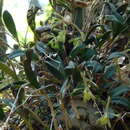en
names in breadcrumbs


Epidendrum conopseum, synonym Epidendrum magnoliae,[1] sometimes called the green-fly orchid, is a species of orchid in the genus Epidendrum. It is the most northern-growing epiphytic orchid in North America, being found wild in the southeastern United States from Louisiana to North Carolina, and also in northeastern Mexico (Nuevo León, San Luis Potosí, Tamaulipas).[2][3][4]
Epidendrum conopseum grows on the branches of evergreen and deciduous trees at low elevations less than 100 m (330 ft) above sea level. Leaves are broadly elliptical, up to 10 cm (3.9 in) long, thick and almost leathery. One plant will produce 6-14 flowers, pale green to bronze-colored.[2]
The diploid chromosome number of E. conopseum has been determined as 2n = 40, the haploid chromosome number as n = 20.[5]
Epidendrum conopseum, synonym Epidendrum magnoliae, sometimes called the green-fly orchid, is a species of orchid in the genus Epidendrum. It is the most northern-growing epiphytic orchid in North America, being found wild in the southeastern United States from Louisiana to North Carolina, and also in northeastern Mexico (Nuevo León, San Luis Potosí, Tamaulipas).
Epidendrum conopseum grows on the branches of evergreen and deciduous trees at low elevations less than 100 m (330 ft) above sea level. Leaves are broadly elliptical, up to 10 cm (3.9 in) long, thick and almost leathery. One plant will produce 6-14 flowers, pale green to bronze-colored.
The diploid chromosome number of E. conopseum has been determined as 2n = 40, the haploid chromosome number as n = 20.